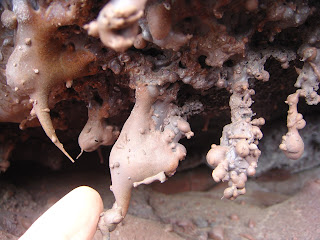Tech'no'woe, n.
1. a term invented by the author of Snow Crash to denote grievous distress, affliction, or trouble arising from difficulties with information technology devices.
2. a state of frustration and exasperation from trying to deal with too many @#%$! electronic gizmos and gadgets
3. a glitch, problem or failure of software or hardware that results in much wasted time, effort and emotional energy to solve or remedy.
I am not a Luddite. I am not a technophobe. I do not shun modern technology, as evidenced by my cell phone, Ipod Nano, two Ipod Touches, one Ipad, one laptop, two desktop computers, a wireless home network, two GPSr's, a flatscreen HD tv interfaced with a home theater sound system and dvr, wireless home alarm system, even a battery-operated corkscrew. And I'm pretty savvy at maintaining my tech arsenal and keeping its software and hardware up to date.
I enjoy using these devices -- they're useful, entertaining, informative, and they generally enrich my life. Indeed, it is hard to imagine doing without them. My life would be much more difficult and tasks would be much more time-consuming. No "Googling" a topic to get instant answers to almost any question, no mobile access to the thousands of tunes in my music collection, no online banking or computer-assisted financial record keeping and financial planning, no watching t.v. shows at my convenience and without commercials, no quick exchanges of messages with friends and family, no talking on a cell phone at the beach, an airport bathroom or a supermarket queue! How primitive life was in the ancient past of 20-30 years ago, before we had these devices! How did we do it?
Now the big HOWEVER. As wonderful as all this technology is, my experiences with it are sometimes frustrating, exasperating, and a huge waste of time. This is partly due to the sheer number of devices, so that one or more of them always seems to have a problem at any given time. Another reason is that their underlying workings have become increasingly complex and opaque, making the causes and cures of glitches much more difficult to figure out. I've nicknamed these technical failures "technowoes." Here are a few recent examples:
The Forced Upgrade That Shortened My Life By Two Days
For many years I've relied on a certain well-known financial program to keep track of my money and to help me plan for retirement spending. The great thing about this software is that with a touch of a button it will update the value of my portfolio, give me a current net worth value, and project my financial balances into the future given current spending levels. As a retiree I find this is really helpful for budgeting and financial decision-making.
The software company upgrades the program every year or so but the newer versions generally don't have a huge advantage over the current one so I don't automatically purchase the upgrade. However, after a few revisions the company withdraws support of the one feature I find essential -- the portfolio update -- and makes it available only in the newest edition. Cha-ching! Forced upgrade.
I recently shelled out the money for the new version and installed it on one of my computers. The installation seemed to go smoothly enough at first, with no cryptic error messages or system crashes. But then... technowoe. As part of the upgrading process my old data file was converted to a new format. When I ran the new program my balances were now wrong for several investments, obviously a major snafu. Puzzled, I proceeded to spend many hours comparing the old and new data to see where the problem was, re-installed the new program several times, and in general pulled every trick I had in my Geek-wannabe repertoire. I finally solved the problem in a way I'll talk about later. But in the meantime this piece of technology that I relied heavily on was a major pain in the rear.
The "Free" Security Program That Actually Cost a Lot of Antacid
My old employer, Miami University, wisely furnished students and faculty with a fairly good anti-virus program that included regular updates provided at no cost through its site license. As a retiree I was able to continue using the program and its update service.
Recently, however, university budget cuts led to the (unwise, imho) elimination of this service, with the somewhat lame recommendation that users switch instead to Microsoft Essentials -- a mediocre replacement that is free to anyone with a Windows PC. Being the paranoid fellow that I am, I searched for a better (but still free) program by going to several authoritative sources that compare and evaluate software. I settled on one and installed it without major problems.
For a couple of weeks everything seemed to be fine, including the automatic updating feature (a crucial aspect for any anti-virus software). Then the problems started. One of my computers would suddenly freeze and it wasn't apparent why. This of course required rebooting the system, a time-consuming procedure akin to watching paint dry or grass grow. A day or two would go by and then this would happen again, always without warning and without any obvious cause. Since the last change to the computer was installing the anti-virus program I began to suspect it was the culprit, though why it would crash my system was a mystery. I finally determined that the software was indeed the likely problem in a way I'll discuss later. I selected another anti-virus program that so far has worked fine. Difficulty solved, but with a lot of wasted time and frustration...and technowoe.
The Acceleration of Obsolescence
Back in the good old days (maybe 5-10 years ago) if you bought a new techno-toy you could expect several years of service before (1) it physically crapped out, (2) its lack of features compared to newer models made it either embarrassingly inferior or (3) the increased demands of new software outstripped the device's resources.
Not now.
Case in point is the blindingly fast obsolescence of my Apple products. When the IPOD Touch first came out I was very intrigued with it but didn't buy one right away. I'm not what the marketing gurus call a "First Adopter" -- I wait to see what the final verdict on new techno-toys will be and for the bugs to be worked out of the first round of devices. When the 2nd generation Touches came out I was ready, and bought one in March of '09. This was my second Apple product and it won me over immediately, especially because of its usefulness during the considerable traveling that my wife and I do -- maps, email, destination info, itinerary details, etc.
Less than three years passed before its features and performance were so inferior to the newest version that in January of '12 I shelled out for a 4th generation model. Among the must-have features were a front and rear-facing camera capable of stills and movies, and the ability to sync information with our other Apple product, an Ipad. But my original 2nd generation Itouch is too decrepit and old to allow syncing -- in less than three years it went from wondrous techno-toy to techno-brick. The late Steve Jobs was truly a marketing genius.....
The Recursive Cure for Some TechnoWoes
I mentioned above that I was eventually able to solve my problems with the financial program update and the new anti-virus software. I did this by using technology to overcome technological problems, namely by Googling or Binging my symptoms. (The obsolescence of my Apple product was solved more crassly -- by spending money.)
Using a search engine to look for solutions to technowoes almost always leads to the revelation that no matter how unusual or odd you think your difficultly is there are others who have had the same or similar problems. It also reveals something that has been true of the internet since it began -- there are many very smart people out there who are willing to share their knowledge and help you solve your problem. This sense of community and mutual support was at one time the hallmark of the "net," and it is very gratifying to find that there is a remnant of it in today's commercialized, socialized and politicized cyberspace.
The online repositories of technical wisdom used to be in various "USENET Groups" which were topical forums where people posted questions and others offered answers. Although the information you needed was probably there in the forum somewhere, in the early days there was no easy way to search previous discussions -- you simply had to look through the old postings or consult a FAQ that tried to summarize the most common questions and answers. These open forums still exist, of course, as do company-sponsored support forums. But now searching for key words or for the entire wording of an error message is almost absurdly easy with search engines like Google and Bing. The value and usefulness of this information is dramatically increased by its retrievability. In fact, try to imagine the internet/WWW without search engines -- I doubt very much that its growth and infiltration of our lives would have been nearly as dramatic as it has been.
I should add that using technology to fix technological problems may still require a bit of Geekiness. The information provided online often requires translation into ordinary language and sometimes involves arcane actions, like issuing "command line commands," or using REGEDIT. Of course, an alternative is to use a company's customer support service. However, I phone tech support only as a last resort because it usually involves even more wasted time waiting for the call to go through, then struggling though a long frustrating session trying to understand the guy on the other end with a thick accent who claims his name is "Bob" or "Eric."
Technowoe is probably with us to stay. It's part the price we pay for living in a wondrously technological era, and overall probably worth it.
But there are times when I yearn for the days of fewer gadgets and fewer problems. Pass me my slide rule and typewriter, please.








